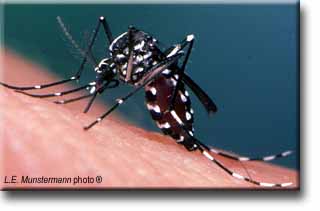Reducing Dengue Disease
Using Biological Agents
For "Kids of All Ages," especially those below 5th Grade
What's it all about?
Dengue is an infection that is carried by mosquitoes and can cause severe
disease in people. It can cause headaches, pain, and rash, and, in more
severe forms, can cause internal bleeding and death. Currently, there
is no vaccine for dengue, and the most widely used methods of control
are chemical agents. These insecticides sometimes can harm the environment
as well as people. For this reason, scientists are looking for better
ways to prevent the spread of dengue.
Various living things, also known as biological control agents, can
be used to prevent infections carried by mosquitoes in place of chemicals
that may hurt the environment.
What's the problem?
People seek long-term and environmentally friendly relief from dengue
outbreaks.
Dengue is a disease that occurs in the tropics, in cities as well as
in villages. A few people have been infected who live in southern Texas
in the United States.
The disease is called "breakbone fever" because of the pain that may
occur in a person's joints. The internal bleeding that sometimes follows
repeated infection can be fatal.
Programs made to prevent dengue by trying to kill the adult stage of
the mosquitoes that carry this infection frequently fail because the adult
stage of Aedes
aegypti, the main kind of mosquito that carries dengue,
stays in villages and towns where they are difficult to find and kill.
Old tires and trash are places where these mosquitoes reproduce. Also,
the containers of drinking water, another place where these mosquitoes
live, must not be contaminated with potentially harmful chemicals.
What can be done?
For these reasons, people seek to use biological control agents that
can get into hard to find places, will not hurt people, and do not cost
too much.
"Biological control" means that people use different kinds of living
things, called organisms, and other biological products, many of which
can spread by themselves or are not harmful to the environment. This information
is here to explain the best ways to use this kind of intervention to keep
people from getting dengue.
ANTIADULT AGENTS (Agents that would kill the adult mosquito)
A biological
agent that would really help to reduce risk of dengue would kill or
injure the adult mosquitoes. Some chemicals that have been used in houses
destroy other animals such as spiders and ants. These mosquitoes, then,
lose their enemies, and can reproduce and live. For this reason, spraying
of chemicals might not stop outbreaks of this disease. Needed are biological
control agents that act directly on the length of life, the way they eat,
and the ability of an adult to spread this disease.
Sometimes various animals can help stop the spread of a disease. For
example, some scientists found that a different kind of mosquito in Hawaii
frequently bit cats and remarked that this could decrease the number of
people getting dengue. This early finding showed that a large range of
different animals and plants might protect people against dengue infection.
This idea still needs to be tested.
ANTILARVAL AGENTS (Agents that would kill the mosquito in the larva
stage)
Aside from hurting the developmental stages of a mosquito before it
matures, the most important thing this kind of agent could do would be
to decrease the number of adults. Reduced larval density, however, does
not always mean fewer adults (Agudelo-Silva and Spielman 1984; Washburn
et al. 1990). Destruction of some larvae in a site may increase risk of
human disease because the death of some mosquitoes in a site may make
the surviving mosquitoes stronger.

Aedes aegypti (female),
primary vector of dengue-hemorrhagic fever
around the world.
FISH
Some fish that eat mosquitoes may be able to reduce the number of mosquitoes
that spread a disease. These fish include catfish and other small fish
used in China, such as Claris fuscus.
TADPOLES
Tadpoles might also decrease the number of mosquitoes by feeding on their
larvae (Spielman and Sullivan 1974). The tadpoles of Giant Cuban tree
frogs, for example, destroy insects in water.
OTHER MOSQUITOES: PREDATION
Various kinds of mosquitoes destroy other mosquitoes.
The larvae of a kind of mosquito known as "toxorhynchites" reduce the
density of A. aegypti by eating their larvae; they are found in the same
kinds of containers. Sometimes there are problems with the use of the
toxorhynchites mosquito for control of dengue.
Other predatory insects, such as dragonflies, may be useful for this
purpose, as well (Sebastian et al. 1990). These observations suggest that
a predator that is satisfactory for use in tanks of drinking water must
be large enough to consume many larvae in a short time, cling to the sides
of the container so that it will not be lost when water is removed, develop
slowly enough that it need not be replaced frequently and be able to survive
for months when no larval mosquitoes are available as food. This model
may cost too much money.
OTHER MOSQUITOES: DISPLACEMENT
Certain mosquitoes appear to eliminate A. aegypti from whole regions
(Gilotra et al. 1967). Indeed, this happened in large portions of the
southern United States within a few years (Rai 1991). Reproduction may
provide another mode of displacement. In the event that the males of one
kind of mosquito were to mate with, but not effectively fertilize, the
females of another, the fertility of those females might be impaired (Spielman
and Kitzmiller 1967). Then, the population would be unable to continue
to produce more mosquitoes.

Aedes albopictus (female),
the Asian Tiger Mosquito,
a recent invader mosquito into North and South America,
Africa and Europe; a rural, secondary vector of dengue.
OTHER MOSQUITOES: GENETICALLY MODIFIED STRAINS
A discussion of "vector control" should also mention the potential of
genetics for use against mosquito-borne infection (Curtis 1990). Genetics
is the study of how characteristics are carried from a parent to a child.
The development of ways to change genes of mosquitoes is believed to provide
hope for stopping this disease. The main goal is to change the genes of
mosquitoes in order to reduce the ability of the mosquitoes to serve as
carriers of disease and eventually to release these mosquitoes in nature
such that the wild mosquitoes will eventually be replaced. However, there
are several problems with this approach.

Frontal poses of male and female each
of Aedes aegypti (left) and Aedes albopictus (right)
OTHER INSECTS: HORMONOMIMETIC
COMPOUNDS
Certain other kinds of substances, called compounds, can be designed
that would block development of particular kinds of insects (Williams
1967). One of these compounds, called methoprene, now promises to be the
most environmentally safe chemical usable against mosquitoes and could
possibly be used in drinking water.
CYCLOPOIDS
The ability of certain "water fleas" to decrease dengue was noticed
when they were seen eating newly hatched larvae of mosquitoes. These copepods,
known as "water fleas," appear to limit the abundance of certain kinds
of mosquitoes. Not all copepods, however, can eat mosquitoes.
A series of other field trials are currently being conducted in different
parts of the world to determine if this is a good way to prevent transmission
of disease. Some of the results show that it could be helpful. The cost
is not too high, and there is little environmental risk. However, there
are still possible problems.
PROTOZOA
Parasites provide prospects for the destruction of mosquitoes. Although
parasites do not affect all kinds of mosquitoes, in some, as the larvae
eat these parasites, they can destroy mosquitoes (Walker et al. 1987).
MICROSPORIDIA
Until recently, the microsporidian
pathogens, some of which kill mosquitoes, did not appear useful to
prevent dengue because they did not survive where A. aegypti live. Recent
findings, though, show that this might be a possibility (Sweeney and Becnel,
1991). Microsporidians might cause an infection in mosquitoes that would
kill them or inhibit their growth.
BACTERIA
BTI is a proven, environmentally safe substance that is nontoxic for
people. It is good because it only destroys mosquitoes and not their predators,
such as spiders. However, this substance can be destroyed by sunlight,
and this may cause the need for weekly visits to each site. This makes
it expensive.
FUNGI
Of the numerous fungi that have been described, there is only one kind
that seems to have potential for stopping mosquitoes from infecting people.
This material holds promise for use against dengue vectors living in potable
(drinking) water. However, there are certain additional problems. It can
be difficult and costly to apply. The fungus infects and kills only a
part of target mosquitoes, as well.
Other fungi, such as Leptolegnia chapmani (Zattau and McInnis 1987)
and Toplocladium cylindrosporum (Ravellec and Riba 1989), present some
potential for anti-dengue programs.
PLANT EXTRACTS
The uses of various plant extracts to decrease the transmission of dengue
are very traditional (Williams 1967). Chrysanthemum flowers, the neem
tree, marigolds, Swartzia madagascariensis -- a variety of an African
plant, and the Ethiopian soap-berry vine all create things that can be
used to stop the spread of dengue (Spielman and Lemma 1973, Minjas and
Sarda 1986, Green et al. 1991). They can be useful in village-level self-help
anti-dengue programs where there are a large number of people willing
to help and where the plants are cheap.
ALGAE
Certain algae seem to fill the guts of larval mosquitoes with material
that they are not able to digest, and this is said to hurt growth (Marten
1986: 1987). Mosquitoes usually live in areas where it is too dark for
algae to grow, however, and so this may not help prevent dengue.
ATTRACTANTS
Possibly, sounds or smells could attract the mosquitoes to a certain
place. This could then be used to determine ways to destroy the mosquitoes.
Efforts to develop this kind of disease control strategy continue to this
day.
MISCELLANEOUS
A broad range of predators and parasites provide potential for developing
ways to prevent dengue. Different kinds of worms and spiroplasms
could decrease the ability of mosquitoes to breed and carry dengue (Case
and Washino 1979, Kerwin and Washino 1985).
COMMENTARY
This case study is one in a series of reviews of the potential of biological
agents for decreasing transmission of one or another vector-borne
disease.
The major requirement of a program that will help to stop transmission
of dengue is the ability to get into obscure bodies of water scattered
within and around the houses in which people live and where A. aegypti
mainly breeds. Toward this end, we require a program of research aiming
at understanding how to limit mosquito density.

Discarded tires, a common urban habitat
of Aedes aegypti and Aedes albopictus
A second requirement for an anti-dengue program is the potential for
use in potable (drinking) water. Toward this end, we require a program
of research aiming to develop methods for formulating BTI for this kind
of use.
The most vulnerable point in the dengue transmission cycle lies in the
length of its incubation
period. Toward this end, we require an understanding of the factors
that influence the length of life of vector mosquitoes, and we do not
know what causes these insects to die in nature.
Nearly as sensitive in the continuation of dengue transmission is the
requirement for a vector-host relationship (a relationship between a mosquito
and the host where it feeds) that focuses on mammals that have the ability
to maintain the basic reproductive rate of the thing that causes the disease.
Toward this end, we require an understanding of the behavior of these
mosquitoes.
The requirement for a long-term, sustainable effort makes cost an important
factor in any public health effort.
Most critical in an approach toward suppressing or containing any vector-borne
infection is the ability to pursue research directions on the basis of
practical matters. Any anti-dengue campaign that is designed should have
easy to achieve objectives that are worthwhile and sustainable. Failure
to satisfy any of these criteria may result in the worst public health
harm, an increase in the disease.
Activities and Puzzles
 Crossword
Puzzle - Reducing Dengue Disease. Crossword
Puzzle - Reducing Dengue Disease.
top of page | next
page
(references and credits)
|













